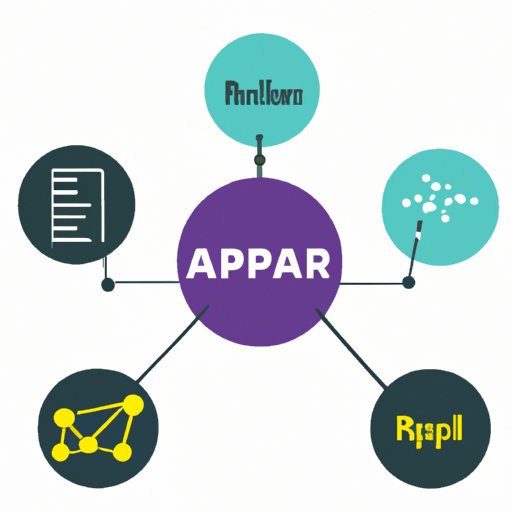Introduction
GraphQL is a revolutionary technology that has quickly gained popularity for creating API’s due to its efficiency and flexibility. In this article, we’ll explore what GraphQL is, its key features, how it differs from RESTful APIs, and how to implement it in your applications.
Section 1: Basics of GraphQL
GraphQL is an open-source data query language and runtime that was developed by Facebook in 2012. GraphQL was created to simplify API development and enable developers to make more efficient data requests. One key feature of GraphQL is that it enables clients to specify precisely what data they need, instead of getting all the data and then having to filter it.
GraphQL accomplishes this by having clients query a single endpoint, which returns only the requested data. Key features of GraphQL include:
- Strongly Typed Schemas
- Client-Driven Queries
- Declarative Data Fetching
- Runtime Execution
- Real-Time APIs
GraphQL is more efficient than REST APIs because it reduces the amount of bandwidth required for communication between the client and server. It also allows multiple requests to be combined into a single request.
Section 2: Key Concepts of GraphQL
GraphQL has four main concepts: schemas, resolvers, queries, and mutations. Schemas define the types and fields in a GraphQL server while resolvers are responsible for returning data for a query. Queries are responsible for reading data, while mutations are responsible for updating data.
Implementing these concepts in a GraphQL server requires defining a schema, creating resolvers, and executing queries and mutations.
Section 3: GraphQL vs. REST
RESTful APIs are the traditional method used for building web APIs. REST APIs, as opposed to GraphQL, don’t have a strict schema, which can lead to over-fetching or under-fetching of data. With GraphQL, developers can retrieve only the data needed for a specific operation.
GraphQL APIs also use a single endpoint, which simplifies the communication between the client and server and eliminates the need for versioning endpoints. RESTful APIs, on the other hand, rely on multiple endpoints, which can become difficult to manage over time as an application evolves.
Both GraphQL and RESTful APIs have their own strengths and weaknesses, and the choice between the two will depend on the use case, application scale, and the development team’s preference.
Section 4: How Netflix Built a Faster, More Efficient API Using GraphQL
Netflix’s main challenge was managing the vast amount of data in its backend systems and ensuring reliable access to that data for its tens of millions of users worldwide. To address the problem, Netflix decided to switch to GraphQL to create a unified API for all its platforms. This change allowed Netflix to avoid custom API endpoints and instead, developers could write their own queries using the new API endpoint.
The change to GraphQL had an immediate impact on Netflix’s development velocity, with developers reporting they could create new features four times faster than before. Netflix also saw a 60% reduction in the number of API requests sent, which resulted in a faster and more reliable user experience.
Section 5: Best Practices for Designing and Implementing GraphQL APIs
Designing and implementing GraphQL APIs efficiently requires careful consideration of several factors. For example, it’s essential to keep the API schema clear and simple, avoid naming conflicts, and handle errors properly. Query optimization is also crucial when working with large datasets or multiple endpoint queries. Additionally, maintaining and testing the API regularly is critical.
Section 6: Overview of Tooling and Frameworks for Building GraphQL APIs
Several tools are available for building GraphQL APIs, including Apollo, Graphcool, and Hasura. These tools help developers implement schema definitions, offer integrated development environments (IDEs) for testing, and provide extensive documentation for their APIs.
When choosing the right GraphQL tool or framework for your project, it’s essential to consider factors such as its ability to integrate with other tools and frameworks, scalability, and ease of use.
Section 7: How to Build a Simple GraphQL API using Node.js and Express.js
Integrating GraphQL with a basic Node.js API using Express.js is relatively simple. First, developers should create a schema with defined fields and data types, followed by defining the resolvers that return the required data. Next, developers need to create a new GraphQL server with the Express.js server, and finally, endpoints need to be defined.
Implementing a GraphQL server using Node.js and Express.js is straightforward and highly efficient, which may be an excellent choice for small to medium-sized projects that hope to gain performance benefits from utilizing a GraphQL server.
Conclusion
GraphQL is an efficient technology that makes data requests and responses easy and hassle-free for developers. Its declarative query language enables better productivity compared to traditional REST APIs. Choosing the correct technology for your project is essential for both best performance and ease of development. With this beginner’s guide, we hope you’re ready to explore GraphQL further and utilize its immense potential.
